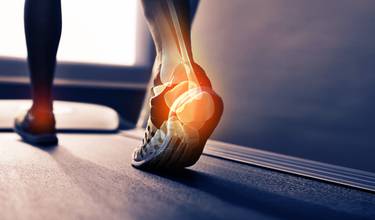Causes of heel spurs
Usually, the ligament functions as a shock absorber, but continuous strain on the heel can lead to the formation of small cracks in the tissue. When the tissue is damaged, inflammation might occur. The result of this inflammation is a heel spur or plantar fasciitis, which causes sharp heel pain.
There are several causes of heel spurs. Continuous strain from strenuous physical activity and sports involving jumping can lead to inflammation of the ligament. Frequent use of stiletto heels might also lead to infection and overload of the ligament. In addition, a job that requires long hours of standing upright or walking increases the risk of developing a heel spur. People with flat feet can also have a predisposition to heel spurs. Flat feet can cause an uneven distribution of weight when a person walks, which puts even more strain on the feet and the ligament.
Exercise and heel spurs
Heel spurs can disturb a person’s exercise routines. By continuing to carry out certain activities, the pain in the heel might worsen. However, keeping the foot inactive is no good solution either. It is possible to exercise despite having a heel spur. The key is to avoid activities that place a lot of strain on the heel. Activities like rowing, swimming, and weightlifting are suitable.
Stretching the ligament
According to the American Academy of Orthopaedic Surgeons, certain types of stretching exercises can alleviate the heel pain and prevent future heel spurs.
The exercise routine consists of three steps:
- Sit in an upright position on a chair or bed with your legs crossed. Place the affected foot on the knee of the opposite leg. Grab the affected heel with one hand and the toes with the other hand. Carefully, pull your toes upwards while simultaneously pulling the heel upwards. When the toes are stretched upwards, the ligament is stretched. Bending the ankle stretches the Achilles tendon, and this could help alleviate the pain. Keep the stretch for approximately 10 seconds. Let go of the foot and repeat 10-20 times. If both feet are affected, repeat the stretch on the other foot.
- Sit on a chair, keep your leg straight while simultaneously alternating between stretching and bending the ankle. This exercise stretches both the ligament and the calf muscle. Repeat 10 times with each foot.
- Place your hands on a wall, keep the back of your leg straight and the heel flat against the floor. Pull your hips forward towards the wall until you feel a stretch on the back of your lower leg. Keep the stretch for 10 seconds and repeat several times. If you experience heel pain on the other foot as well, repeat the exercise on the opposite leg.








